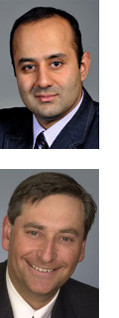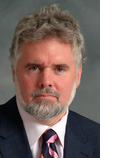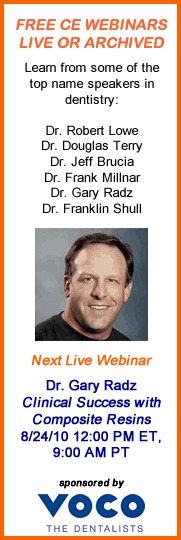A member service that keeps you up-to-date on important new literature relevant to your practice.
 |
|
In this issue of JCDA Express, our contributors highlight articles on periodontal regenerative procedures, joint replacement prophylaxis, burning mouth syndrome and risk factors for oropharyngeal and oral cavity cancer.
JCDA gratefully acknowledges the generosity of the publishers of the selected articles, who have granted free access to the full-text papers until September 13, 2010. Follow the links in the Notes and News sidebar to find out more about these publications.
Previous issues of JCDA Express can be found on our newly redesigned website at JCDA.ca. I invite you to browse the site and let me know what you like and dislike and how we can make it more appealing. In particular, please visit the Products & Services section and tell me what would make this area more useful and compelling for you.
Yours sincerely,
Dr. John P. O'Keefe
Editor-in-chief
jokeefe@cda-adc.ca
|
|
 |
|
|
Periodontal Regenerative Procedures

Dr. Amir Azarpazhooh is a PhD/specialty candidate in endodontics and a lecturer in dental public health at the faculty of dentistry, University of Toronto.
Dr. Howard Tenenbaum is a professor of periodontology at the University of Toronto, University of Manitoba and Tel Aviv University, Israel. He is also vice-chair of the Federal Dental Care Advisory Committee, Health Canada.
Drs. Azarpazhooh and Tenenbaum recommend:
Periodontal regenerative procedures for patients with periodontal disease: a review of clinical effectiveness. Canadian Agency for Drugs and Technologies in Health. Health Technology Inquiry Service Report. Ottawa, Ontario. 5 March 2010.
View full text of this report
Full-text access to this article has expired.
Key points:
- Open flap debridement (OFD) is one surgical technique that attempts to regenerate periodontal tissues. Examples of OFD include the modified Widman flap, the simplified or modified papilla preservation technique and the coronally advanced flap.
-
Common forms of adjunctive therapy to OFD include guided tissue regeneration (GTR), bone graft substitutes (BGS) and enamel matrix derivatives (EMD).
-
According to this report, the majority of evidence shows that the use of EMD, GTR and BGS as adjunctive to OFD yields significant benefit in clinical outcomes for the treatment of intrabony defects, as measured by gain in clinical attachment level and reduction in pocket probing depth.
-
The findings of 3 randomized controlled trials do not support the use of EMD during routine nonsurgical scaling and root planing.
-
Compared to OFD, the use of GTR was found to significantly improve bone gain for treatment of intrabony defects and attachment gain for treatment of furcation defects in first mandibular molars.
-
With the exception of bioactive glass, the application of other BGS in conjunction with OFD resulted in significant gain in bone fill for the treatment of intrabony defects.
-
It should be noted that the outcome measures reported in the review were extremely variable. Therefore, even though the procedures produced significant improvements, the magnitude of these improvements is questionable.
-
Further research on periodontal regenerative procedures is necessary, preferably with more reliable outcome measures and clear definitions of disease.
Reasons for recommending this article:
This report was prepared for the Federal Dental Care Advisory Committee, a committee of oral health professionals who provide advice to the Office of the Chief Dental Officer and to the 6 federal departments that directly provide dental services to clients. The report is an objective review of the evidence on the clinical effectiveness of periodontal regenerative procedures compared to standard surgical or nonsurgical periodontal procedures that was undertaken by members of the Canadian Agency for Drugs and Technologies in Health, a research team that had no preconceived notions regarding the expected outcomes of the different treatments.
|
|
 |
|
|
|
| |
Joint Replacement Prophylaxis

Dr. Blaine Cleghorn is assistant dean of clinics and associate professor in the department of dental clinical sciences, faculty of dentistry, Dalhousie University. Dr. Cleghorn recommends:
Little JW, Jacobson JJ, Lockhart PB and the American Academy of Oral Medicine. The dental treatment of patients with joint replacements: a position paper from the American Academy of Oral Medicine. J Am Dent Assoc. 2010;141(6):667-71.
View full text of this article
Full-text access to this article has expired.
Key points:
-
The American Academy of Orthopaedic Surgeons (AAOS) released an Information Statement in February 2009 which “recommends that clinicians consider antibiotic prophylaxis for all total joint replacement patients prior to any invasive procedure that might cause a bacteremia.”
-
This AAOS Information Statement is a major departure from the 2003 American Dental Association (ADA)/AAOS guideline that included the following statement: “The risk/benefit and cost/effectiveness ratios fail to justify the administration of routine antibiotic prophylaxis.”
-
The February 2009 AAOS Information Statement was developed without the involvement of organized dentistry or other non-orthopedic medical specialties and did not provide an evidence-based rationale for such a dramatic change in position.
-
This recent JADA article (which is a position paper of the American Academy of Oral Medicine, AAOM) recommends that a systematic review of antibiotic prophylaxis use in patients with total joint replacements be undertaken. Until this systematic review is performed, the authors recommend that the February 2009 AAOS information statement not replace the 2003 ADA/AAOS guidelines.
Reasons for recommending this article:
The February 2009 AAOS Information Statement has resulted in confusion and concern in the dental community with respect to recommendations on antibiotic prophylaxis for patients with total joint replacements. This JADA article (and AAOM position paper) offers an evidence-based rationale for reconsideration of the AAOS position. Until then, the authors provide guidance for the practising dentist by offering 3 options when managing patients with total joint replacements in their dental practice—inform patients with prosthetic joints about the risks associated with antibiotic prophylaxis use and let them decide; continue to follow the 2003 ADA/AAOS guidelines; or suggest to the orthopedic surgeon that they both follow the 2003 guidelines.
|
|
 |
|
|
Burning Mouth Syndrome

Dr. Joel Epstein is a professor in the department of oral medicine and diagnostic sciences, University of Illinois at Chicago, College of Dentistry. Dr. Epstein, a JCDA editorial consultant, recommends:
Zakrzewska JM, Forssell H, Glenny AM. Interventions for the treatment of burning mouth syndrome. Cochrane Database of Systematic Reviews 2005, Issue 1. Art. No.: CD002779. DOI: 10.1002/14651858.CD002779.pub2.
View full text of this article
Full-text access to this article has expired.
Key points:
-
Burning mouth syndrome (BMS) is a chronic pain disorder, consistent with neuropathic pain, predominantly seen in peri- and post-menopausal women.
-
BMS may be associated with other symptoms including dry mouth and taste change.
-
Diagnosis of BMS is essentially based upon clinical presentation, a lack of potentially related underlying systemic disorders and mucosal tissue within normal limits. Symptoms are typically symmetrical in distribution and most commonly involve the tongue and may extend to the palate and lips.
-
This 2005 Cochrane review applies stringent inclusion criteria for studies on BMS, resulting in limited guidelines for clinical care.
-
From the included studies, the review presents results on 3 approaches to the management of BMS: cognitive behavioural therapy, clonazepam and alpha-lipoic acid. Of these 3 options, clonazepam has shown promise. Although alpha-lipoic acid did show potential benefit, more recent studies are not positive. The study on cognitive behavioural therapy had poorly defined outcome measures.
Reasons for recommending this article:
This Cochrane review effectively summarizes the evidence base for BMS up until 2005. The review suggests potential approaches for the management of BMS, but more controlled studies with adequate sample sizes are needed using validated outcome measures. Such gaps in the research prompted the planning of a workshop on BMS, to be held August 28, 2010, in Montreal, Quebec, before the 13th annual meeting of the International Association for the Study of Pain.
|
|
 |
|
|
Oropharyngeal and Oral Cavity Cancer

Dr. Bob Wood is chief of dental oncology, ocular and maxillofacial prosthetics at Princess Margaret Hospital, Toronto, Ontario. Dr. Wood recommends:
Auluck A, Hislop G, Bajdik C, Poh C, Zhang L, Rosin M. Trends in oropharyngeal and oral cavity cancer incidence of human papillomavirus (HPV)-related and HPV-unrelated sites in a multicultural population. The British Columbia experience. Cancer. 2010;116(11):2635-44.
View full text of this article
Full-text access to this article has expired.
Key points:
-
Oropharyngeal cancers are becoming more common than oral cavity cancers. The increased incidence of oropharyngeal cancers may be due to human papillomavirus (HPV)-related infections transmitted through changing sexual practices, specifically exposure to a greater number of sexual partners and an increase in oral sexual practices. The decreasing incidence of oral cavity cancers, commonly associated with tobacco and alcohol abuse, may be attributed to a decrease in the number of smokers.
-
This article reinforces current thinking that HPV is a significant factor in the development of upper aerodigestive tract malignancies. Therefore, dentists should properly examine patients they might not consider to be at risk for these cancers—namely nonsmokers of both genders.
-
Changing oral sexual practices have led to the increase in HPV-related cancers, and unsafe oral sexual practices (e.g., multiple sexual partners, not using condoms) may contribute to further increases in oropharyngeal cancers.
-
Because sexual behaviour is an uncomfortable subject to discuss with patients in a private practice setting, the risks of HPV-related cancers should be clearly communicated through public health measures and population education efforts.
-
As for oral cavity cancers, policy makers must recognize that because Canada is a multicultural society, a "one-size-fits-all" public health campaign targeting smoking cessation will not solve the problem in all communities. For instance, use of betel quid is a recognized risk factor in South Asian populations.
-
Dentists should try to be aware of the particular oral habits of all patients in their practices and target individual screening and preventive efforts appropriately.
Reasons for recommending this article:
This article provides a fine summary of several current areas of interest in the field of upper aerodigestive tract malignancies. It offers a reminder to dentists to educate and examine patients not normally considered susceptible to these types of cancers. The article also shows that past efforts to modify behaviour (e.g., smoking or tobacco use) have positive outcomes on the incidence of oral cavity cancers. Similar efforts directed at other community-based risk factors (such as multiple oral sexual partners) might have similar positive effects on oropharyngeal cancers.
|
|
|
|
|

JCDA is the authoritative written voice of the Canadian Dental Association, providing dialogue between the national association and the dental community. It is dedicated to publishing worthy scientific and clinical articles and informing dentists of issues significant to the profession.

|

|
NOTES AND NEWS
Share your volunteer experiences on the new DISCUSSIONS section of the JCDA website
www.jcda.ca/discussions/
Check out the publications featured in this issue
Journal of the American Dental Association
(publisher: American Dental Association)
Cochrane Reviews
Cancer
(publisher: Wiley)
Mark your calendar for the CDA convention
The next CDA convention
will take place in Halifax,
August 4-6, 2011.
Stay tuned for more information at
cdaconvention2011.com
Search the JCDA Classified Ads
Looking for employment? Want to sell your practice? Classified ads offer the most effective way to reach all dentists and students in Canada.
Spread the word
Help spread the word about JCDA Express by telling your colleagues about it and reminding them to send CDA their email address.
reception@cda-adc.ca
|
|
|

|

|
|



